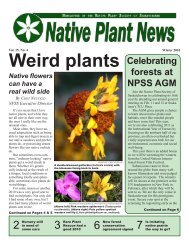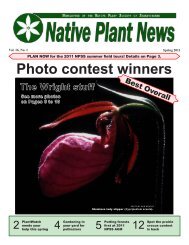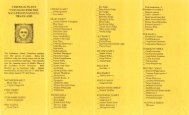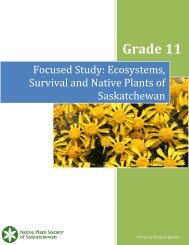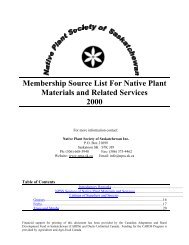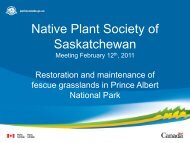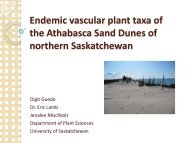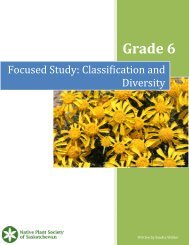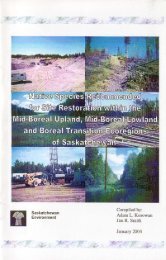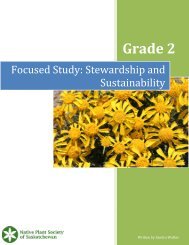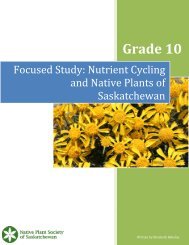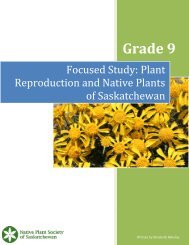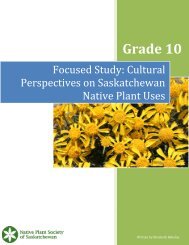Saskatchewan Guidelines For Use Of Native Plants In Roadside ...
Saskatchewan Guidelines For Use Of Native Plants In Roadside ...
Saskatchewan Guidelines For Use Of Native Plants In Roadside ...
Create successful ePaper yourself
Turn your PDF publications into a flip-book with our unique Google optimized e-Paper software.
<strong>Saskatchewan</strong> <strong>Guidelines</strong> <strong>For</strong> <strong>Use</strong> <strong>Of</strong> <strong>Native</strong> <strong>Plants</strong> <strong>In</strong> <strong>Roadside</strong> Revegetation<br />
Field Guide<br />
Spring seeding generally takes place from mid April to late May, and even into June if<br />
spring was unusually late, or if precipitation is high enough in June.<br />
Advantages of Spring Seeding<br />
- Seed/seedlings will probably avoid any killing frosts.<br />
- Seed/seedlings take advantage of residual spring moisture and early summer heat.<br />
- Seed will germinate before little if any predation can occur.<br />
- Good seed to soil contact to help germination.<br />
Disadvantages of Spring Seeding<br />
- If soil too moist, site access is restricted.<br />
- If soil extremely moist, seed rot can occur.<br />
- If soil extremely dry, seed may not germinate.<br />
- If moist spring is followed by a dry summer, seedlings can die.<br />
- If seed doesn’t germinate, it may be too late to re-seed.<br />
Fall seeding generally takes place from mid October until it is too cold or snowy to do so.<br />
The soil temperature must be below 5°C to prevent seed from prematurely germinating.<br />
Advantages of Fall Seeding<br />
- Seed is in place to receive all moisture from snowmelt in addition to spring<br />
precipitation.<br />
- Seed may germinate and establish faster than if spring-seeded.<br />
- Over-wintering may break seed dormancy and introduce scarification and temperature<br />
stratification, all of which are beneficial for germination.<br />
Disadvantages of Fall Seeding<br />
- Seed/seedlings may be exposed to killing temperatures.<br />
- Frost may decrease seed to soil contact.<br />
- <strong>In</strong>creased chance of seed predation due to lengthy dormant period in soil.<br />
- Seedlings with premature germination in fall will be killed by winter.<br />
- If seed doesn’t germinate, there is still time to re-seed.<br />
Winter seeding is possible; however, there are many disadvantages to using this method<br />
such as frost damage to seed, seed predation, seed loss from wind and runoff, and poor<br />
seed to soil contact. Also the impracticalities associated with this process make it<br />
generally unfavourable.<br />
Summer seeding is not advised, as the seed will probably not get established before<br />
winter, resulting in establishment failure and costly reseeding. It is possible to seed warm<br />
season grasses early in summer, but fall and spring seeding are still more viable options<br />
for these species.<br />
A. Broadcast Seeding



